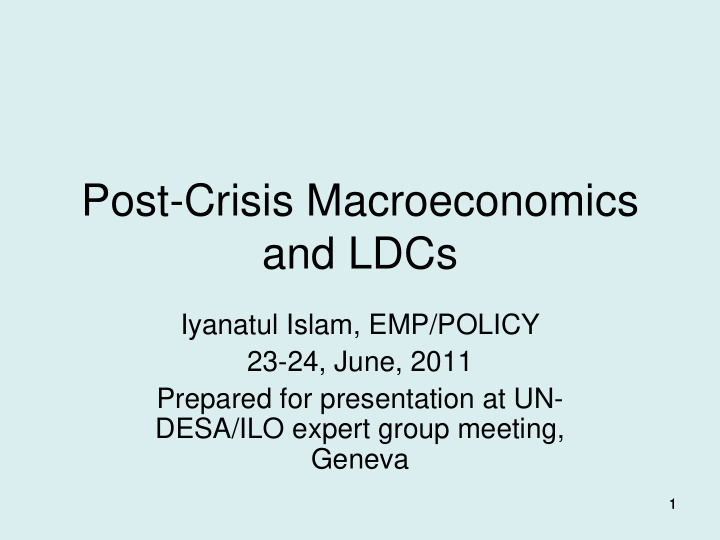



Post-Crisis Macroeconomics and LDCs Iyanatul Islam, EMP/POLICY 23-24, June, 2011 Prepared for presentation at UN- DESA/ILO expert group meeting, Geneva 1
Key messages • Improvement in macroeconomic performance of LDCs in 2000s • But concerns about decline in public investment and high borrowing costs • Exacerbates binding constraints on private sector growth • Evidence that at country-level macropolicy advice still reflects ‘business as usual’ • Need to recapture ‘revisionist moment’ of mid-2000s • Align macropolicy with core development goals (MDGs +SPF) • Example with fiscal policy design
Higher growth, lower inflation in LDCs in 2000s 3
Lower macroeconomic volatility in LDCs in 2000s 4
5
But..secular decline in public investment…. 6
Higher borrowing costs, despite reduced inflation 7
8
Implications? • Higher borrowing costs and reduced public investment exacerbates binding constraints on private sector development in LDCs • Enterprise-level surveys show lack of access to finance, high cost of credit and low quality infrastructure among top ten constraints • Conventional macroframework not effective in dealing with these binding constraints
Business as usual? • Review of policy statements for 30 LICs and 20 MICs from IMF Article IV consultations (2010 mostly) show: • An emphasis on fiscal adjustment • Some emphasis on inflation targeting • Insufficient alignment with development goals 10
Business as usual? IMF Policy Statements for 30 LICs and 20 MICs: Frequency Distribution 60 48 50 40 27 30 20 6 10 1 0 0 Explicit reference to Explicit reference to Explicit reference to Fiscal adjustment Explicit inflation MDGs MDG 1b: Full Social Protection targetting employment and Floor decent work 11
Revisionist moment of mid-2000s • Who said that? • …(T)he scope for monetary policy to impede growth far exceeds its ability to create it: high inflation above, for example, 40 per cent – is certainly inimical to growth, but keeping inflation low will not by itself induce a growth boom
Revisionist moment of mid-2000s • Who said that? • Controlling the growth of government liabilities… offer little indication of longer term effects on government assets or on economic growth. Conceptually, the long- term impact is better captured by examining the impact of fiscal policy on government net worth.
Post-crisis macroeconomics and LDCs LDCs Binding MDGs 2015 constraints +SPF on private sector Post-crisis Macroeconomics
What post-crisis macroeconomics ought to be: an illustration using fiscal policy • What is needed… • Resources to meet nationally adapted MDGs and social protection floor while maintaining fiscal sustainability • Simultaneously can help relieve binding constraints on private sector • Hence…. fiscal diamond to identify sources of sustainable resources 15 15
The Fiscal Diamond (adapted from 2006 Dev Cttee of IMF/WB) 1. External Assistance (% of GDP) 4. Reprioritization 2. Dom estic Revenue & Efficiency of Expenditures Mobilization (% of GDP) (% of GDP) 3. Deficit Financing (% of GDP) 16 16
Determining the size and shape of fiscal diamond to meet employment creation goals: example • Bangladesh (Islam et al , 2010) • Employment Guarantee Scheme or EGS (to Indian standard) will cost 1.9% of GDP (2009- 2010 prices) • Bdesh has tax-GDP ratio around 9% of GDP • EGS can be met entirely through a moderate increase in tax-GDP ratio by 3% points and better utilization of existing resources 17 17
Concluding remarks • Pro-development fiscal policy needs to be complemented by… • Monetary and financial sector policies that support financial inclusion • Encouraging diversification through… • Competitive and stable real exchange rate • Prudent capital account management • Strengthening labour market institutions 18
Recommend
More recommend